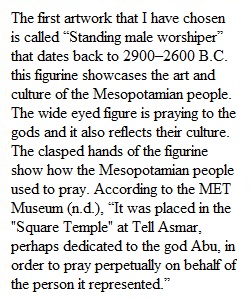


Q Closer to Van Eyck is part of a recent trend in the art and museum world—the digitization of art. The most powerful online resource is certainly the Google Arts and Culture Project, released in 2011. Visit the Google Arts and Culture Project. This amazing website features high-resolution reproductions of more than 32,000 works in 31 mediums and materials from the collections of more than 150 museums and arts organizations around the world. You can visit individual works, travel through museums using Google Street View technology, and make your own galleries of your favorite objects. For this week's History in Art discussion, please choose three objects and share with the class. Copy and paste the URLs of each object into your post so that we can explore what you found. Choose works from any culture, but from three distinct historical periods, and write briefly about why you chose what you did. Imagine that you are curating your own exhibition of these three works. One question you might ask yourself: Do the patterns we have been exploring in this class express themselves in the three choices you made? Or, does a different pattern emerge? Your post should be two to three (well-developed) paragraphs long. You may also upload descriptive text, a YouTube link, or an MP3 file. View and comment on at least one of your classmates' posts.
View Related Questions